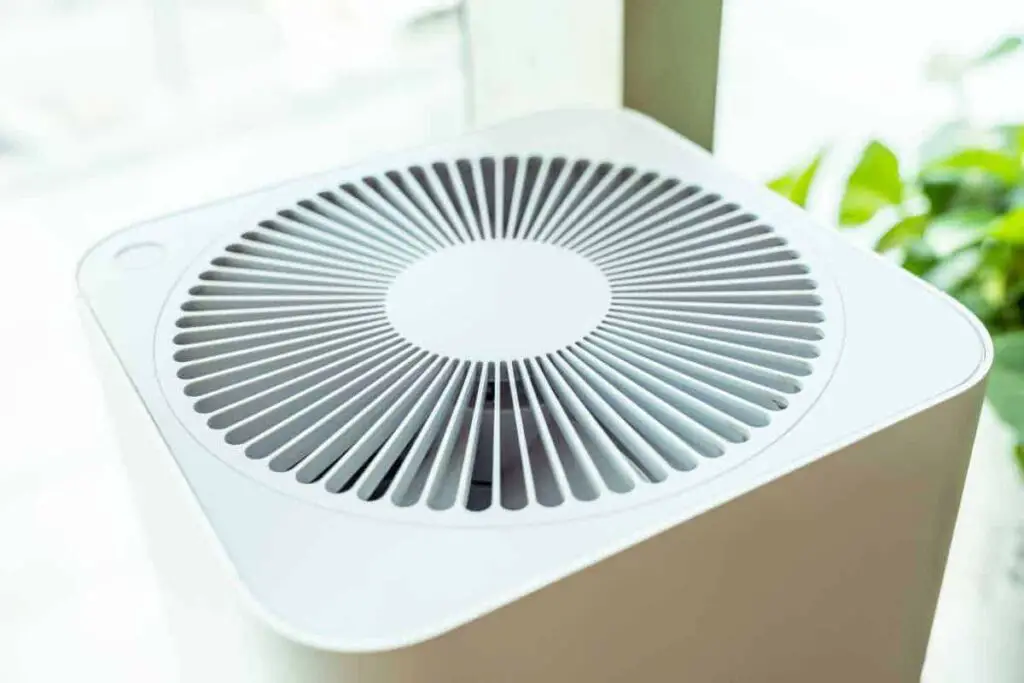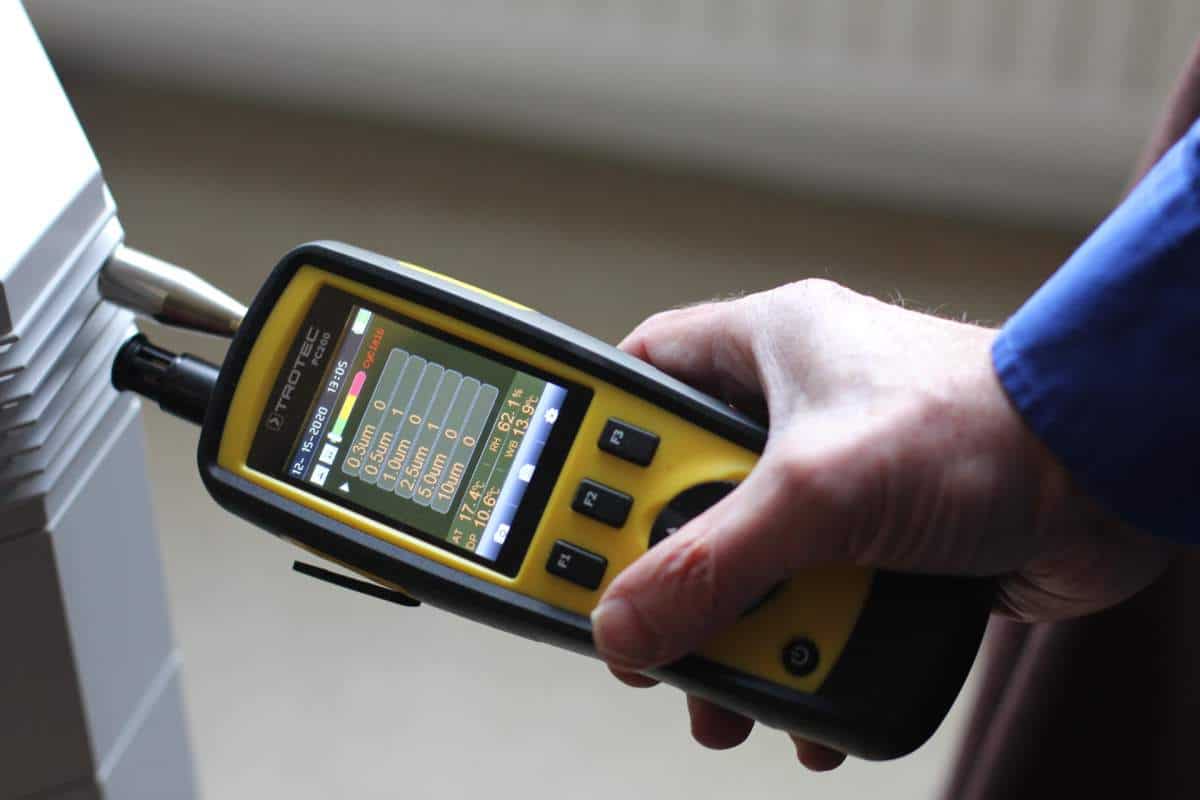As particles in the air are invisible and as they rarely smell, it is impossible to know if your air purifier is working using your senses. There is only one effective solution for this problem-
As a general rule you should use an air quality meter to measure the air quality before you switch the air purifier on and then when it has been running continuously for an hour. You should see at least an 80% drop in the number of particles in the air.

If not, you need to investigate further-
Testing Basic Air Purifier Function
The first way to test an air purifier is to put your hand close to the outlet from the air purifier when it switched on you should be able to feel the breeze coming out which increases as you turn the fan speed up. If you first did this when the air purifier was fairly new, you will know what to expect at the maximum setting. You may detect that at the maximum setting there is not as much air coming out as when the air purifier was new.
You can also open up the air purifier and do a visual check on the filter.
If it is completely clogged up with dust, then you need to change the filter.
However the most important factor is the number of particles in the air that you are breathing deep into your lungs. So even if the filter looks clogged, if it is reducing the number of particles in the air adequately you may wish to postpone the filter change. If the filter has got to the end of the manufacturer’s recommended change period then it is best to change it.
The reason for changing it although it seems to be working is because of how the particle meter that you will have works. The particle meter that you will have is based on laser diffraction technology, and this can only detect 100% of particles at a diameter of 0.5 micrometres. However over 90% of the particles in the air are much smaller than this. They can be detected, but only with very expensive detectors, costing about $4000. So your particle count of the larger particles is used as an indication of the number of much smaller particles. It is not an actual count of these very small particles.

The number of ultrafine particles does not always follow the number of fine particles that you meter will read so when the filter reaches the end of the manufacturers specified life it is best to replace it.
Test an Air Purifier’s Ability to Remove Particles From the Air
Testing for All Air Purifiers
Air quality meters are not expensive and start at $35, as outlined in this article. At the cheap end of the range, they will count a proportion of the particles, but not every particle. If you want a meter that is certified as accurate, then you will need to pay $200, and for a very accurate particle counter $1000-5000.
The first thing to check is the air at the outlet from the air purifier to see if the particle count is zero or at least very low. Again, it is helpful but not essential, to have a reading from when the air purifier was brand new, so you know how much deterioration there has been .
You should test the quality of the air at the point in the room where you are breathing. The air purifier itself may work, but because of its position in the room or because of its air cleaning capacity, it may not be effective enough. To check this, you would check the air in the part of the room where you will spend the most time. Put the particle meter roughly where your mouth will be and check the air quality. You should see a reduction in the particle count of at least 80% and ideally somewhere near 90%.
You should not rely on the sensor built into the air purifier to check the quality of the air. They are built with cheaper less sophisticated, less accurate technology and so do not accurately measure fine particles. They also cannot detect ultrafine particles at all, these are thought to be very damaging to human health as explained in this article. Also they are not at the position in the room where the air is entering your mouth and so do not reflect the quality of the air entering your lungs.
Additional Tests for Non-Filter Based Air Purifier
Air purifiers that do not have filters will require different checks. Ionizing air purifiers often collect dust on the electrodes. If the electrodes are completely coated with dust particles will no longer be attracted to and collected by the electrode. So simple visual inspection will show you whether there is so much dust that the rods need cleaning. Cleaning the particles off the electrodes will restore the air purifier function.
If there is no collection of dust on the rods over a period of the week, then it is unlikely the device is working. There are models where there is a compartment where dust and pollution collect. Again, if there is no dust in the compartment at the end of the week the device is probably not working.
Unfortunately these types of air purifier are not as effective as air purifiers with HEPA air filters–some of them giving very poor results indeed.
With air purifiers incorporating UV light, you may see either an indicator light showing that the light has stopped working. Another way of telling if the light is working is that you may be able to see a minimal amount of light coming from the air purifier. You should not look directly at the UV light as it may damage your sight.
Testing for the Effectiveness of an Air Purifier in Removing Chemicals
Unlike particles in the air which are impossible to see and do not smell, chemicals in the air can create smells. This can alert you to the need to test an air purifier. You will need to buy a meter that will detect volatile organic chemicals and formaldehyde. These are not expensive, are widely available and start at around $80.
There are also chemical testing kits for mold and mildew. These break down into 2 different categories. In one category you collect a sample using sticky tape or air sampling test kits. This is then sent to the laboratory. There is then a wait while the lab analyzes the sample and gives you the result.
The other method is to use a device that is much like a pregnancy testing kit in its use. The manufacturer – Healthful Home says that it is licensed from the US Public health service and that is trusted by US military EPA labor thousand other government agencies. The problem with this sort of testing is that on the tests mold is either present or not. The test does not give a measure of the amount of mold. Also, a swab is taken from the surface rather than the air being sampled. So this type of testing for mold is not really going to be useful to tell if an air purifier is working. This is because the result with the air purifier on is likely to be much the same as when it is off.
If you want to see if the air purifier is removing mold, you would need to use a method where a sample of a is sent to a laboratory. Samples would need to be taken before switching the air purifier on and then after it has been on continuously for 1 hour.
Laboratory Testing of Air Purifiers
Laboratory testing uses a sealed room. They put smoke and pollen particles into the air. For smoke, they do this by burning something, for instance, burning matches and then using a fan to distribute the smoke throughout the room. When the smoke is fully distributed, a baseline reading is taken. Then the air purifier is switched on and the decrease in particle count with time measured. A similar procedure is followed for pollen particles.
Consumer reports have produced a video outlining how they test air purifiers. A copy of the testing protocol for AHAM (Association of Home Appliance Manufacturers) can be found here.
Conclusion
Testing the air purifier is straightforward. Simply put your hand next to the outlet from the air purifier when it is switched on at its full setting-there should be a good flow of air leaving the air purifier.
If it passes this test next take an air quality meter. Measure the particle count in the part of the room where you will spend the most time at the height that air will be entering your mouth. Then switch the air purifier on and leave it running continuously. Come back after an hour and take another particle count at exactly the same place and height. Ideally, this should be a reduction of 100% in the particle count, although a reduction of 80% is acceptable.
The hidden aspect of using an air purifier is to buy an air quality meter with it-they start at $35. I found without an air quality meter I made so many mistakes with the set up of my air purifiers and it was only when I brought one that I could see how badly I was doing and what I needed to change.
See Also
How to use an air purifier. This article explains important aspects of how to use an air purifier to get the lowest particle count in the air.

